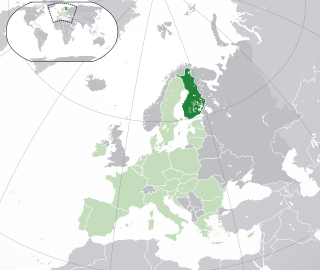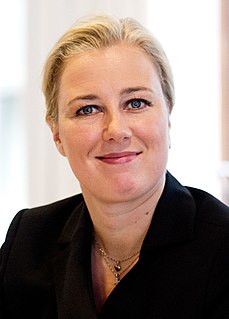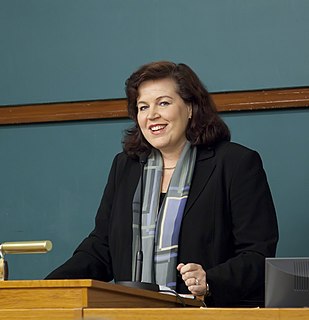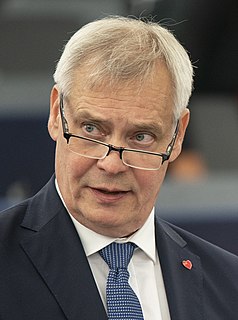Related Research Articles
The National Coalition Party is a liberal-conservative political party in Finland.

The Finns Party, formerly known as the True Finns, is a right-wing populist political party in Finland. It was founded in 1995 following the dissolution of the Finnish Rural Party.

Jyrki Tapani Katainen is a Finnish politician who served as the European Commission's Vice-President for Jobs, Growth, Investment and Competitiveness from 2014 until 2019. Katainen was previously Prime Minister of Finland from 2011 to 2014 and chairman of the National Coalition Party from 2004 to 2014. He was succeeded by Alexander Stubb as chairman of Finland's National Coalition Party. After stepping down as Prime Minister, Katainen was elected as European Commission Vice-President in July 2014.
Same-sex marriage in Finland has been legal since 1 March 2017. A bill for the legalisation of same-sex marriages was approved by the Finnish Parliament on 12 December 2014 and signed into law by President Sauli Niinistö on 20 February 2015. The law took effect on 1 March 2017.

Lesbian, gay, bisexual, and transgender (LGBT) rights in Finland are among the most advanced in Europe. According to an annual ILGA report, Finnish LGBT legislation is among the most extensive and developed legislations in Europe. Compared to fellow Nordic countries, it ranks near the top, outranked only by neighbouring Norway. Both male and female same-sex sexual activity have been legal in Finland since 1971 with "promotion" thereof decriminalized and the age of consent equalized in 1999, and homosexuality declassified as an illness in 1981. Discrimination based on sexual orientation in areas such as employment, the provision of goods and services, etc, was criminalized in 1995 and discrimination based on gender identity in 2005.

Timo Juhani Soini is a Finnish politician who is the co-founder and former leader of the Finns Party. He served as Deputy Prime Minister of Finland from 2015 to 2017 and Minister of Foreign Affairs from 2015 to 2019.
Northern Savonia was an electoral district represented in the Finnish Eduskunta (parliament). Since 2013 it has been part of the Savonia Karelia electoral district. It covered the administrative region of Northern Savonia, with a population of about 251,000. Northern Savonia currently elects ten members of the Eduskunta.

Parliamentary elections were held in Finland on 18 March 2007. Early voting was possible from the 7–13 March. The 200 members of the Eduskunta were elected from 15 constituencies.
The 2009 European Parliament election in Finland was the election of the delegation from Finland to the European Parliament in 2009.

Jutta Pauliina Urpilainen (born 4 August 1975 in Lapua) is a Finnish politician. She was the first female chairman of the Social Democratic Party of Finland, which she led from 2008 to 2014. She was the Minister of Finance of Finland from 2011 to 2014. As of 1 December 2019, she is a commissioner in charge of international partnerships in the European Commission led by Ursula von der Leyen.

Anne Elisabeth Holmlund is a Finnish politician and Minister of the Interior of Finland from 2007 to 2011. She was a Member of Parliament for the National Coalition Party from 2002 until 2015.

Parliamentary elections were held in Finland on 17 April 2011 after the termination of the previous parliamentary term. Advance voting, which included voting by Finnish expatriates, was held between 6 and 12 April with a turnout of 31.2%.
Opinion polling in the 2011 Finnish parliamentary election began in January 2010, just over a year before the April 2011 election. The major difference between the polls before 2011 and the polls before previous elections was the larger-than-expected support for the True Finns.

The Katainen Cabinet was the 72nd cabinet of Finland, formed as a result of the 2011 post-parliamentary election negotiations between the Finnish parliamentary parties. Led by Prime Minister Jyrki Katainen of the National Coalition Party (NCP), 12 ministers of the 19-minister government represented the NCP and the Social Democratic Party (SDP), while the Left Alliance, the Green League, the Swedish People's Party (RKP) and the Christian Democrats share seven minister portfolios. On June 22, the Parliament confirmed Katainen's election as the Prime Minister and President Tarja Halonen inaugurated the government. Two Left Alliance MPs voted against Katainen, for which they were formally reprimanded by the Left Alliance's parliamentary group. On 25 March 2014, the rest of Left Alliance left the cabinet over dispute on a package of spending cuts and tax rises.

The Social Democratic Party of Finland, shortened to the Social Democrats and commonly known in Finnish as Demarit, is a social-democratic political party in Finland. It is currently the largest party in the Parliament of Finland with 40 seats.

Parliamentary elections were held in Finland on 19 April 2015, with advance voting taking place from 8 to 14 April. The 200 members of the Parliament of Finland were elected with the proportional D'Hondt method.

The Stubb Cabinet was the 73rd Government of Finland, which stepped into office on 24 June 2014. It succeeded Jyrki Katainen's cabinet. The cabinet's prime minister was Alexander Stubb.

Parliamentary elections were held in Finland on 14 April 2019. For the first time, no party received more than 20% of the vote. The Centre Party, which had been the largest party following the 2015 elections, dropped to fourth place, losing 18 seats and recording its lowest vote share since 1917. The Social Democratic Party saw the biggest gains, winning six more seats and narrowly becoming the largest party for the first time since 1999. The Green League and the Left Alliance also gained five and four seats respectively.

Blue Reform was a Finnish conservative political party.
References
- ↑ "Kokoomus ja Sdp vaativat: Portugalin myytävä omaisuuttaan" (in Finnish). Helsingin Sanomat. 11 May 2011. Retrieved 13 May 2011.
- ↑ "Soini jättäytyi oppositioon dramaattisissa tunnelmissa" (in Finnish). Helsingin Sanomat. 12 May 2011. Retrieved 12 May 2011.
- ↑ "Seppänen Kansan Uutisille: Sdp teki täydellisen takinkäännön" (in Finnish). Helsingin Sanomat. 13 May 2011. Retrieved 13 May 2011.
- ↑ "11 kansanedustajaa jättäytyy kevään 2011 vaaleista" (in Finnish). HS.fi. 9 February 2010. Archived from the original on 25 April 2011. Retrieved 18 April 2011.
- ↑ "Perussuomalaiset jättäytyvät hallitusneuvotteluista" (in Finnish). YLE. 12 May 2011. Retrieved 12 May 2011.[ dead link ]
- ↑ "Finnish PM-elect invites Greens and CDs to five-party coalition". Helsinki Times. 14 May 2011. Archived from the original on 25 July 2011. Retrieved 14 May 2011.
- ↑ "Vihreät lähtee hallitusneuvotteluihin vain tiukoilla ehdoilla" (in Finnish). Helsingin Sanomat. 14 May 2011. Retrieved 15 May 2011.
- ↑ "Katainen ottaa hallitusneuvotteluihin myös vasemmistoliiton ja vihreät" (in Finnish). Helsingin Sanomat. 18 May 2011. Retrieved 18 May 2011.
- ↑ "Six-party government in the making". Helsingin Sanomat. 19 May 2011. Retrieved 21 May 2011.
- ↑ "Finland's PM-elect opens "rainbow" government formation talks with 6 parties". The Canadian Pres. 21 May 2011. Retrieved 21 May 2011.
- ↑ "Government Negotiations Consider Cuts". YLE. 19 May 2011. Retrieved 21 May 2011.
- ↑ "Party Leaders to Continue Government Talks on Saturday". YLE. 20 May 2011. Retrieved 21 May 2011.
- ↑ "Eduskunta hyväksyi Portugalin tukipaketin" (in Finnish). Eduskunta. 25 May 2011. Archived from the original on 11 August 2011. Retrieved 8 June 2011.
- ↑ "SDP ja vasemmistoliitto ulos hallitusneuvotteluista" (in Finnish). YLE. 1 June 2011. Retrieved 1 June 2011.
- ↑ "Vihreät ei lähde porvarihallitukseen MTV3 Katsomo" (in Finnish). Bonnier Group. 6 June 2011. Retrieved 19 June 2011.
- ↑ "Katainen: Keskustan ja perussuomalaisten kanssa keskustellaan" (in Finnish). 3 June 2011. Archived from the original on 21 October 2012. Retrieved 19 June 2011.
- ↑ "Jyrki Kataisella on nyt aikaa perjantaihin asti" (in Finnish). Helsingin Sanomat. 7 June 2011. Retrieved 8 June 2011.
- ↑ "Katainen jatkaa hallitustunnusteluja kuuden puolueen kanssa" (in Finnish). Helsingin Sanomat. 10 June 2011. Retrieved 10 June 2011.
- ↑ "Katainen: Hallitusohjelma pian valmis" (in Finnish). MTV3. 14 June 2011. Archived from the original on 16 June 2011. Retrieved 17 June 2011.
- ↑ "Mustajärvi ja Yrttiaho ulos vasemmistoliiton eduskuntaryhmästä". Helsingin Sanomat (in Finnish). Sanoma News. 30 June 2011. Retrieved 30 June 2011.
- ↑ "Uuden hallituksen salkkujako" (in Finnish). Helsingin Sanomat. 17 June 2011. Archived from the original on 23 July 2011. Retrieved 18 June 2011.
- ↑ "Perhe? Koulutus? Työkokemus? Tässä ovat uudet ministerimme" (in Finnish). Bonnier Group. 18 June 2011. Retrieved 18 June 2011.
- ↑ "Kristillisten Päivi Räsänen ottaa vastuun maahanmuuttoasioista" (in Finnish). Helsingin Sanomat. 18 June 2011. Archived from the original on 19 June 2011. Retrieved 18 June 2011.
- ↑ "Vasemmistoliitto hallitukseen – Arhinmäestä kulttuuriministeri" (in Finnish). Yleisradio. 19 June 2011. Archived from the original on 28 July 2011. Retrieved 19 June 2011.
- ↑ "Hallituksessa 19 ministeriä, salkkujaossa yllätyksiä" (in Finnish). Helsingin Sanomat. 17 June 2011. Retrieved 17 June 2011.
- 1 2 "Uusi hallitus nimitettiin". Helsingin Sanomat (in Finnish). Sanoma News. Suomen Tietotoimisto. 22 June 2011. Archived from the original on 25 June 2011. Retrieved 12 July 2011.
- ↑ "Jyrki Katainen becomes Prime Minister". Finnish Broadcasting Company. 22 June 2011. Archived from the original on 6 January 2013. Retrieved 12 July 2011.
- ↑ "Poll: Slim majority expect government without True Finns to stay in power". Helsingin Sanomat. 20 May 2011. Retrieved 21 May 2011.
- ↑ "Kiviniemi: Kataisen vasemmistohallitus unohti lapsiperheet" (in Finnish). Yleisradio. 18 June 2011. Retrieved 19 June 2011.
